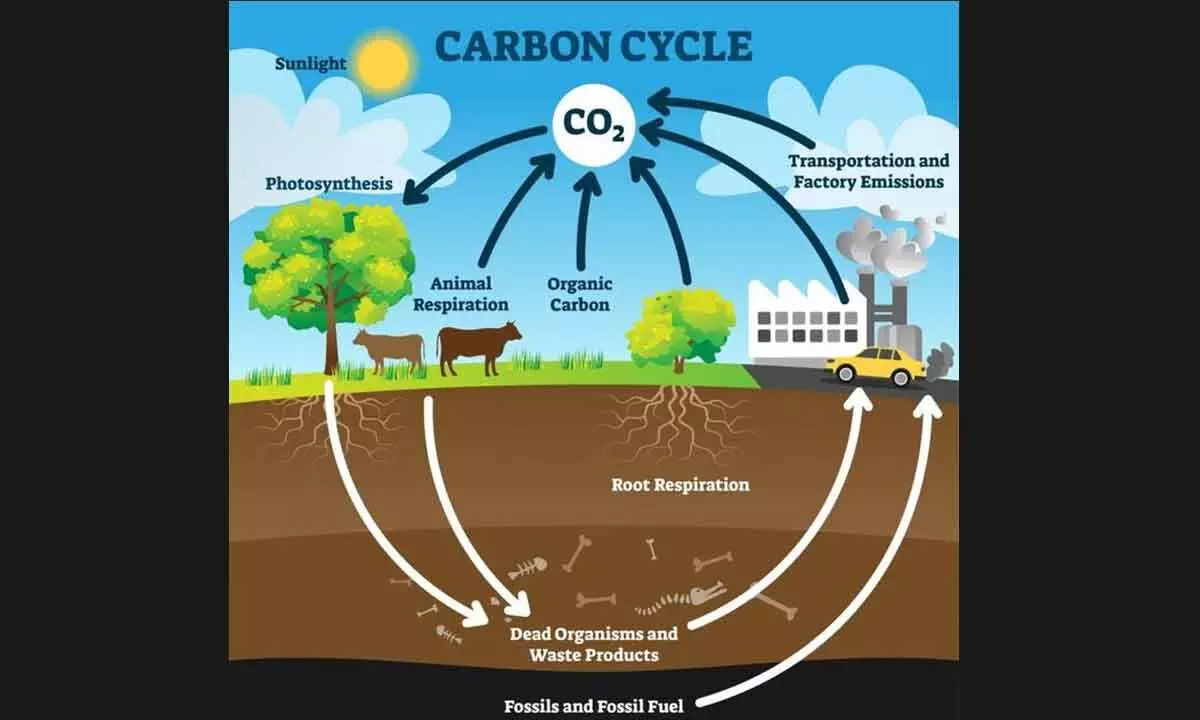Unless contained, inorganic carbon in soil can cause climate change and industrial pollution
Soil in India and China is becoming more acidic due to acid rain, industrial pollution and intense farming
image for illustrative purpose

Irrigation and fertilisation of farmland speed up the rate at which soil inorganic carbon is dissolved and leaches out of the soil. Inorganic carbon has accumulated in soil over vast periods of earth's history. Disturbances to this carbon will have a profound impact on soil health
We all know about carbon in earth's atmosphere, in plants and bodies of animals. But a substantial fraction of the carbon in the planet's land-based ecosystems is held in something so obvious we might overlook it: soil. Even if we do think about carbon in soil, we are usually thinking of carbon in soil’s organic matter like such as plant litter, bacteria and animal waste. However, the inorganic, mineral component of soil also contains carbon.
In a new study recently published in ‘Science’, we show that there is much more soil inorganic carbon than anybody realised – and that it may be a surprisingly big player in earth's carbon cycle. We analysed over two lakh soil measurements from around the world to calculate that the top two metres of soil globally holds about 2.3 trillion tonnes of inorganic carbon. This is about five times more carbon than found across the world's terrestrial vegetation. We estimate some 23 billion tonnes (one per cent) of this carbon may be released over the next 30 years, with poorly understood effects on earth's lands, waters and atmosphere.
Inorganic carbon:
Inorganic carbon exists in soils in various forms. It can be trapped carbon dioxide gas, dissolved in water or other liquids, or it can be in solid form as carbonate minerals. Most of the inorganic carbon by weight is solid carbonates, often calcium carbonate (a common substance found in materials such as limestone, marble and chalk). They give soil a whitish look, while organic carbon makes it dark. Soil carbonates can come either from weathering of rocks or from the reaction of soil minerals with atmospheric carbon dioxide. Inorganic carbon tends to build up more in soil in arid and semi-arid environments such as Australia. That's because when water runs through soil it tends to carry away some of the carbonates with it. Our estimates show the top two metres of Australia's soil harbours some 160 billion tonnes (seven per cent) of the world's inorganic carbon. This makes Australia home to the fifth-largest pool of soil inorganic carbon in the world. In wetter regions, soil carbonates may also be found along rivers and around lakes and coastal areas, in the form of calcium-rich alluvial deposits or calcareous rocks. Soils in karst regions – areas rich in rocks like limestone and often characterised by caves and sinkholes – typically contain carbonate in rocks. In areas such as central Asia large deposits of wind-blown sediments (loess) contribute to the accumulation of carbonate minerals.
Why should we care?
This huge pool of carbon is affected by changes in the environment, especially soil acidification. Acids dissolve calcium carbonate, meaning the carbon dissolves in water or is released as carbon dioxide gas. Soil in many regions of the globe (such as India and China) is becoming more acidic due to acid rain and other pollution from industrial activities and intense farming. Scientists have viewed carbonates in soil as a relatively stable pool of carbon that changes only slowly over time. However, human activities have made soil inorganic carbon more mobile. Irrigation and fertilisation of farmland speed up the rate at which soil inorganic carbon is dissolved and leaches out of the soil. Inorganic carbon has accumulated in soil over vast periods of earth's history. Disturbances to this carbon will have a profound impact on soil health. This compromises soil's ability to neutralise acidity, regulate nutrient levels, foster plant growth and stabilise organic carbon. Not only does soil inorganic carbon act as a store of carbon, it also supports soil's many crucial functions in ecosystems.
In our research, we found that 1.13 billion tonnes of inorganic carbon are lost from soils each year to inland waters. This loss has profound yet often overlooked effects on carbon transport between the land, freshwater bodies, the atmosphere and the oceans.
How to go about it?
There is a growing recognition of the importance of soil carbon as a fundamental part of nature-based solutions to combat climate change. However, much of the focus so far has been on organic carbon. Our research shows inorganic carbon warrants equal attention. Improved land practices can reduce disturbance to the global pool of soil inorganic carbon, and may even be able to make it bigger. In agriculture, making irrigation and fertilisation better adjusted to plant growth needs can reduce impact on inorganic carbon. In some soils, organic amendments such as compost and manure can protect against acidification, improve calcium levels and increase soil inorganic carbon.
Our research shows efforts to mitigate climate change by sequestering carbon in soil must incorporate inorganic carbon as well as organic. Inorganic carbon in soil is linked to global changes such as climate change, industrial pollution and soil overuse in different ways from those of organic carbon. However, some strategies to lock up more carbon in soil – such as enhanced rock weathering, afforestation, and trapping organic carbon in soil minerals – might also serve to increase levels of inorganic carbon.
There are already international soil carbon programs like the four per mille initiative, which aims to increase soil carbon storage by 0.4% annually across the globe. These efforts could further increase their ambition by considering the critical role of inorganic carbon in achieving sustainable soil management and reaching climate targets.
(Yuanyuan Huang is associated with the Chinese Academy of Sciences and Yingping Wang is with CSIRO)

